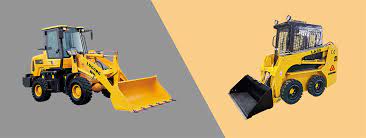SKID-STEER LOADER SAFETY
Workers who operate or work near skid-steer loaders face crushed-by, caught-in, rollover, and runover hazards if safety procedures are not taken. When using skid-steer loaders on the job, personnel must always:
1.use and maintain all of the manufacturer's safety equipment.
2.Enter and exit the loader carefully.
3. follow safe operating techniques
4. adhere to proper maintenance standards
If you are weary or have consumed drugs or alcohol, do not operate heavy machinery. If you are on medication, consult with your doctor to see if you are capable of operating machinery safely.
Workers on foot should keep a safe distance from heavy equipment, utilize only authorized pathways, and wear high-visibility apparel, such as safety vests.
Unintentional control activation is prevented via control interlocks. Before the operating controls of these interlocked control systems to work, a safety device (such as a seat belt or restraint bar) must be appropriately positioned. Before the machine may be used, this component guarantees that the operator is safely positioned away from the zone of the lift arm action.
Seatbelts must be operational, well-maintained, and worn by the operator.
Rollover Protective Structures (ROPS) keep the operator within the loader in the event of a rollover.
Side screens (metal or glass) are included into the ROPS to prevent the operator from reaching out of the operator's compartment and colliding with a moving lift arm. Side screens also keep operators safe from being hurt by debris or anything that enter the vehicle.
Falling Object Protective Structures (FOPS) are installed to keep the operator safe from falling material.
Lift Arm Supports hold the lift arms in place when they are raised. Work under a raised attachment only if the lift arm support device is installed. Concrete blocks or basic metal angle irons should never be used since they might move or collapse under even modest loads.
Moving pieces can crush workers if they do not enter and exit the skid-steer loader cab safely. Workers must climb and dismount carefully to avoid injury when entering and exiting the loader. When the bucket (or other attachment) is flat on the ground or the lift arm support device is in position, enter and depart.
When entering the loader, keep a three-point contact with the handholds and stairs. Foot or hand controls should never be used as stairs or handholds. Maintain clean and clear walking and working areas on and around the loader.
Lower the bucket (or other attachment) to the ground, set the parking brake, and switch off the engine before exiting the operator's seat. If the operator is unable to depart the machine through the primary entrance, they should utilize the emergency exit placed at the back of the operator's compartment or as stated by the manufacturer.
Always follow safe operating and job site practices if you operate or work near skid-steer loaders. Never exceed the load capacity advised by the manufacturer for the loader.
Only operate the skid-steer loader while correctly positioned within the operator's compartment. NEVER try to operate the loader or activate its controls from outside the cab.
If a seat belt or restraint bar is supplied, be sure it is buckled and in place throughout operation. When manipulating the loader controls, always remain seated. While the engine is running, do not leave the driver's seat. During operating, keep all body parts inside the operator's compartment.
When feasible, load, unload, and turn the loader on level ground. Keep the load low. Travel and spin while keeping the bucket as low as possible. Crossing slopes is not recommended. Travel straight up or down, with the loader's heavier end pointing upward. Avoid slick areas. Loaders should only be used on stable surfaces. Always keep an eye on the direction of travel.
Maintain a safe distance between bystanders and the work area, and NEVER carry riders.

If the machine lacks side screens, interlocks, ROPS/FOPS, and seat belts, inquire with the equipment dealer or manufacturer's representative about the availability of field modification kits or replacement parts.When construction equipment such as a skid-steer loader is utilized, construction companies must implement safety and health policies that include frequent and regular inspections of 1) job sites, 2) materials, and 3) equipment by competent personnel.
A routine maintenance and inspection regimen that adheres to the manufacturer's guidelines should be implemented. Before running the skid-steer loader, inspect it to confirm that all safety features are operational. Keep mud, ice, snow, and debris away from the foot controls.
When the engine is switched off, the key is removed, the parking brake is set, the wheels are blocked, and attachments are lowered or supported by an appropriate lift arm support device, maintenance work should be undertaken.
